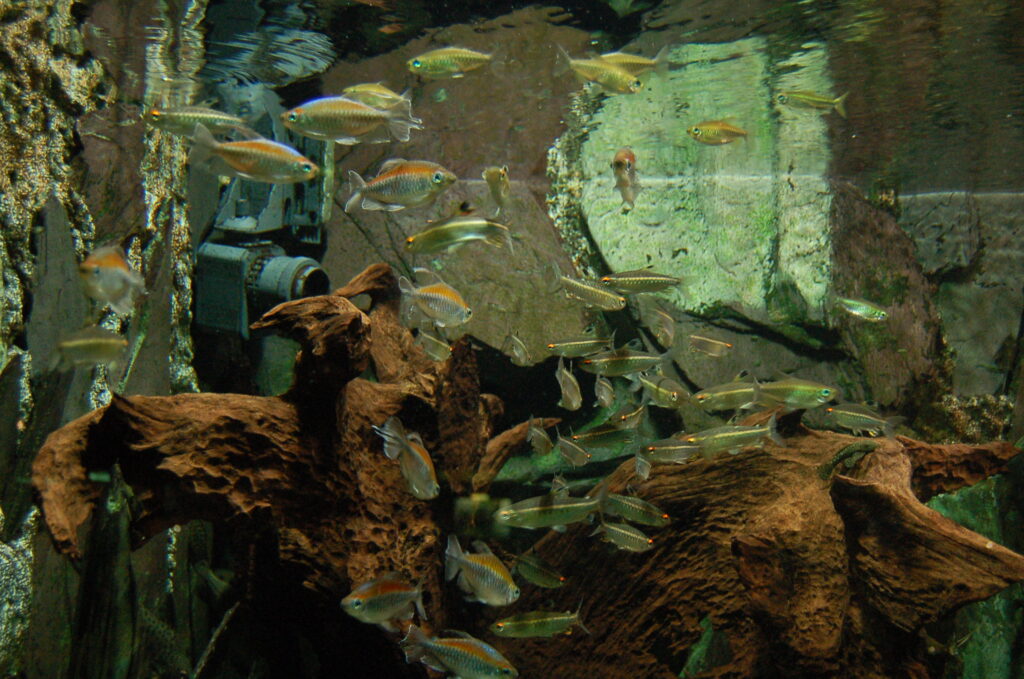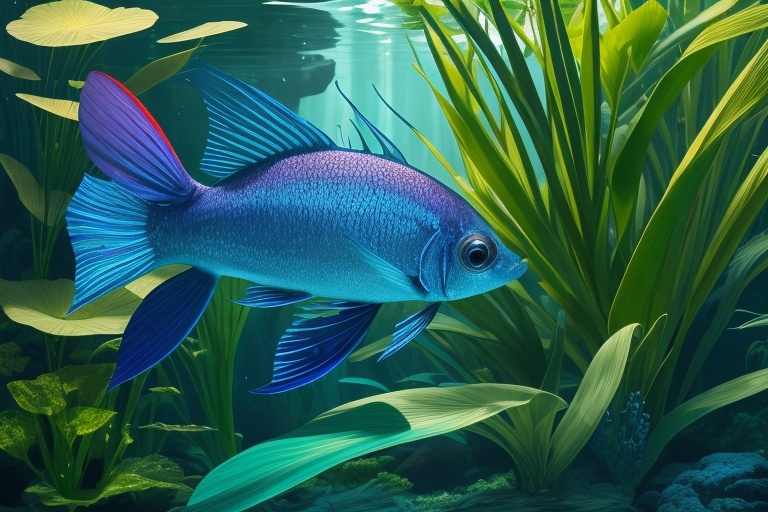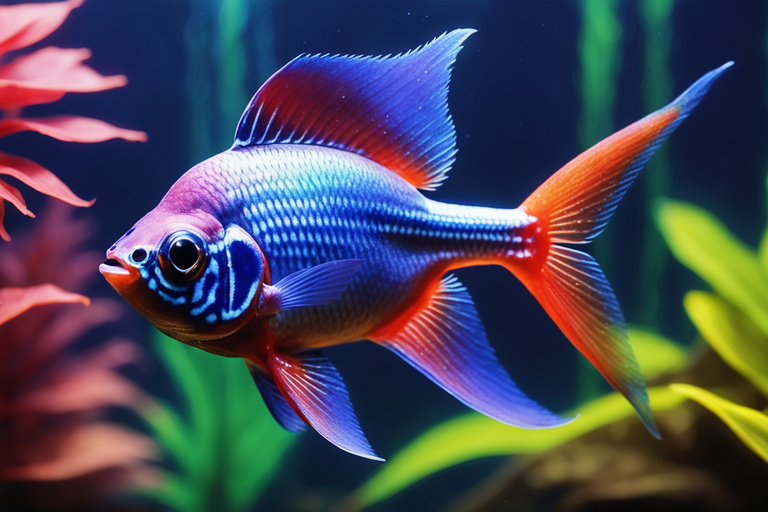Are you interested in learning about the fascinating Congo Tetra? This stunning fish, known for its vibrant coloration and unique adaptations, is a true marvel of nature.
From its elongated body shape to its intricate fins and gill covers, the Congo Tetra boasts a range of captivating physical features.
In this article, we will delve into its habitat, feeding habits, and compatibility with other tank mates. Get ready to explore the world of this remarkable species and discover its ecological significance.
Quick Facts
- Congo Tetra (Phenacogrammus interruptus) is a freshwater fish species that is native to the Congo River Basin in Central Africa14.
- They are known for their bright and vibrant colors, which include shades of red, orange, and blue15.
- Congo Tetra are omnivores and eat a variety of foods in the wild, including insects, worms, plant matter, and algae2.
- In captivity, they are easy to feed and enjoy live, frozen, and flake foods2.
- Congo Tetra are peaceful and social fish that should be kept in groups of at least six individuals in a tank of at least 40 gallons14.
- They prefer soft and slightly acidic water with a pH between 5.5 and 7.515.
- Congo Tetra are relatively low-maintenance fish that are suitable for beginner aquarists1.
- They are susceptible to diseases such as ich and velvet, so it is important to maintain good water quality and provide a healthy diet4.
- Congo Tetra are compatible with other peaceful fish species such as tetras, rasboras, and dwarf cichlids14.
- They are often overlooked in pet stores, but they are incredibly beautiful and make a great addition to any community tank5.
- Habitat: In the wild, they inhabit densely vegetated, soft-water streams and rivers.
- Breeding: They scatter their eggs among plants. Once the eggs hatch, the fry should be fed infusoria or other suitable small foods.
- Lifespan: With proper care, Congo Tetras can live for up to 5 years in captivity.
Habitat and Natural Range
In their natural habitat, you can find Congo tetras swimming in the rivers and streams of Central Africa. The Congo tetra, scientifically known as Phenacogrammus interruptus, belongs to the family Alestidae and is classified under the order Characiformes.
These vibrant freshwater fish inhabit the dense vegetation and clear waters of the African Congo Basin. With their elongated body shape and prominent dorsal and anal fins, they’ve adapted for swift movement and maneuverability in their aquatic ecosystem.
The males boast stunning coloration, displaying iridescent blue and yellow hues on their bodies. This serves as a visual signal during courtship and territorial displays. The Congo tetra is known for its peaceful nature, often forming small shoals in the wild.
Their behavior patterns include feeding on small invertebrates and plant matter, and they’re considered omnivorous. Unfortunately, due to habitat destruction and overfishing, the conservation status of the Congo tetra is listed as ‘near threatened’ by the International Union for Conservation of Nature (IUCN).
Physical Characteristics and Coloration
You’ll notice that the physical characteristics and coloration of the Congo Tetra are truly remarkable. This fish belongs to the family Alestidae and is scientifically classified under the genus Phenacogrammus. It’s predominantly found in the aquatic ecosystems of the Congo River Basin in Central Africa.
The Congo Tetra has a streamlined body shape with dorsal and anal fins that aid in its locomotion. Its gill covers, known as opercula, allow for efficient respiration. However, what truly sets this species apart is its vibrant coloration. The males display a stunning array of iridescent blues, purples, and yellows, while the females exhibit a more subdued color pattern. These colors play a crucial role in the species’ reproductive behavior, attracting potential mates.
The Congo Tetra has a lifespan of around 3-4 years in captivity, making it a relatively short-lived species compared to other tropical fish. Understanding the behavioral patterns, lifespan, and longevity of this species is vital for its conservation and management. Research studies have provided valuable insights into the ecological significance of the Congo Tetra in the aquatic ecosystems it inhabits.
Care Requirements and Tank Setup
To ensure the optimal health and well-being of the Congo Tetra, it’s important to provide them with appropriate care requirements and a suitable tank setup.
The Congo Tetra is a species that thrives in a well-maintained aquatic ecosystem. When setting up their tank, it’s crucial to consider the water parameters. The ideal temperature for the Congo Tetra ranges from 73 to 82 degrees Fahrenheit, with a pH level between 6.0 and 7.5.

Providing them with a spacious tank, ideally around 20 gallons or more, allows for their natural behaviors and reduces stress. Tank decoration options should include plants and driftwood to create hiding spots and mimic their natural habitat.
These vibrant fish greatly benefit from a varied diet consisting of high-quality flakes, pellets, and live or frozen foods.
Feeding Habits and Dietary Needs
When it comes to feeding your vibrant fish, it’s essential to provide them with a varied diet consisting of high-quality flakes, pellets, and live or frozen foods.
The congo tetra, belonging to the genus Phenacogrammus, is a beautiful species found in the rivers of Central Africa. Understanding their feeding preferences and nutritional requirements is crucial for their overall health and well-being.

Here are some key points to consider:
- Omnivorous diet: The congo tetra is an omnivore, meaning it consumes both plant matter and small aquatic organisms.
- Natural diet: In their natural habitat, congo tetras feed on insects, larvae, small crustaceans, and plant matter.
- Balanced nutrition: To replicate their natural diet, offer a mix of high-quality flakes or pellets along with occasional live or frozen foods like brine shrimp, daphnia, or bloodworms.
- Supplement with vegetables: Adding blanched vegetables like spinach, peas, or zucchini can provide essential vitamins and fiber.
Meeting the congo tetra’s feeding preferences and nutritional requirements will ensure their vibrant colors and overall health thrive in your aquarium.
Compatible Tank Mates and Breeding Information
If you want to keep your aquarium harmonious, it’s important to choose tank mates that are compatible with the Congo Tetra.
The Congo Tetra (Phenacogrammus interruptus) belongs to the family Alestidae and is native to the rivers of Central Africa. It’s a popular choice among aquarists due to its vibrant coloration, elongated body shape, and peaceful temperament.
When selecting tank mates, it’s crucial to consider their size, behavior, and water requirements. Good choices include other peaceful species like tetras, rasboras, and peaceful catfish. Avoid aggressive or fin-nipping species, as they may stress or harm the Congo Tetra.

- Other Tetras: Many other tetras, like Neon Tetras, Cardinal Tetras, and Rummy Nose Tetras, can cohabit peacefully with Congo Tetras.
- Livebearers: Guppies, Mollies, Platies, and Swordtails are generally peaceful and can make good tank mates.
- Corydoras Catfish: These are bottom-dwelling, peaceful fish that complement the mid-to-top dwelling Congo Tetras.
- Small Rasboras: Fish like Harlequin Rasboras can be a good match due to their peaceful nature.
- Rainbowfish: While active, most Rainbowfish are peaceful and can share the same tank with Congo Tetras.
- Dwarf Cichlids: Species like Apistogramma and Pelvicachromis are generally mild-mannered and can coexist with Congo Tetras.
- Loaches: Many of the smaller loach species, like the Kuhli Loach or Zebra Loach, can be good companions for Congo Tetras.
- Plecos: Smaller pleco species, such as the Bristlenose Pleco, can be a good fit.
- African Butterfly Fish: This is a unique, surface-dwelling fish that can be kept with Congo Tetras but ensure the tank is well-covered as they can jump.
- Hatchetfish: Peaceful surface dwellers that complement the mid-level swimming Congo Tetras.
- Barbs: While some barbs can be nippy, species like Cherry Barbs are generally peaceful and can be considered.
Precautions:
- Avoid keeping Congo Tetras with large, predatory fish or with species known for fin-nipping, as the long, flowing fins of male Congo Tetras can be a target.
- Always monitor new additions for signs of aggression or stress and be prepared to make adjustments if necessary.
- As with any community tank setup, it’s essential to ensure that all inhabitants have similar water parameter requirements and are compatible in terms of temperament and dietary needs.
Additionally, providing ample hiding spots and tank decorations, such as plants and driftwood, can create a more natural and secure environment for all inhabitants.
Regular tank maintenance, including water changes and monitoring water parameters, is essential for the overall health and well-being of the Congo Tetra and its tank mates.
Conclusion
In conclusion, the Congo Tetra is a fascinating fish species with vibrant coloration, an elongated body shape, and specific adaptations for survival in its natural habitat.
It’s important to provide a suitable aquatic ecosystem and proper care to meet its specific needs.
Understanding its phylogenetic classification, reproductive behavior, feeding habits, and ecological significance can contribute to the overall conservation and understanding of this species.
Scientific research and studies provide valuable insights and support for accurate and up-to-date information about the Congo Tetra.

